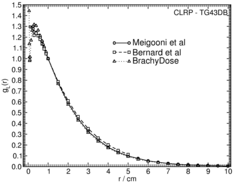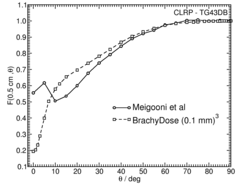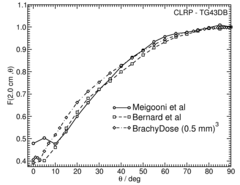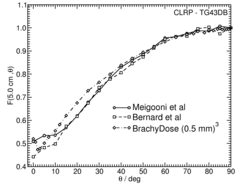

Source Description:
Dimensions for the InterSource seed 1,2 are taken from the study by Meigooni et al . The InterSource consists of two concentric hollow titanium cylindrical tubes which are laser welded together at the ends. Each tube is 0.040 mm thick and the outer diameter of the inner and outer tubes are 0.500 mm and 0.810 mm, respectively. There is a thin band (0.0450 mm thick and 1.27 mm long) of 90% Pt/ 10% Ir alloy deposited on top of the inner cylinder at its center. The radioactive 103 Pd is distributed uniformly throughout three cylindrical bands of an organic material (85.7% carbon 14.3% hydrogen with a density of 1.00g/cm 3, the 103 Pd content is assumed to be negligble) deposited on the outside of the inner cylinder. The outer two bands of radioactive material are deposited on the inner cylinder and are 0.800 mm long, 0.015 mm thick and have their centers along the seed axis offset 1.45 mm from the middle of the seed. The center band is 0.500 mm long, 0.009 mm thick and centered on top of the Pt/Ir alloy while the center of the outer bands are offset from the middle by 1.60 mm. The overall length is 4.5mm and the active length of the seed is taken to be 4.35 mm.
Dose Rate Constant - Λ :
Dose rate constants, Λ , are calculated by dividing the dose to water per history in a (0.1 mm) 3 voxel centered on the reference position, (1 cm,Π/2), in the 30x30x30 cm 3 water phantom, by the air kerma strength per history (scored in vacuo ). As described in ref. 3 , dose rate constants are provided for air kerma strenth calculated using voxels of 2.7x2.7x0.05 cm 3 (WAFAC) and 0.1x0.1x0.05 cm 3 (point) located 10 cm from the source. The larger voxel size averages the air kerma per history over a region covering roughly the same solid angle subtended by the primary collimator of the WAFAC 4,5 at NIST used for calibrating low-energy brachytherapy sources and is likely the most clinically relevant value. The small voxel serves to estimate the air kerma per history at a point on the transverse axis.
| Author | Method | Λ (cGy h-1 U-1) | Abs. Uncertainty |
| R. E. P. Taylor, D. W. O. Rogers 6 | WAFAC | 0.663 | 0.002 |
| R. E. P. Taylor, D. W. O. Rogers 6 | point | 0.664 | 0.002 |
| A. S. Meigooni et al 7 | point (PTRAN) | 0.696 | 0.02 |
| A. S. Meigooni et al 7 | TLD | 0.664 | 0.03 |
Radial dose function - g(r):
The radial dose function, g(r), is calculated using both line and point source geometry functions and tabulated at 36 different radial distances ranging from 0.05 cm to 10 cm. Fit parameters for a modified polynomial expression are also provided 8 .
| Fitting coefficients for g L (r) = (a 0 r -2 + a 1 r -1 +a 2 + a 3 r +a 4 r 2 + a 5 r 3 ) e -a 6 r | ||||||||
| Fit range | Coefficients | |||||||
| r min (cm) | r max (cm) | a 0 / cm 2 | a 1 / cm | a 2 | a 3 / cm -1 | a 4 / cm -2 | a 5 / cm -3 | a 6 / cm -1 |
| 0.10 | 10.00 | 2.2647E-03 | -1.0300E-01 | 1.8601E+00 | -2.9487E-02 | -2.5580E-02 | 2.1394E-03 | 5.3440E-01 |
Anisotropy function - F(r,θ):
Anisotropy functions are calculated using the line source approximation and tabulated at radii of 0.1, 0.15, 0.25, 0.5, 0.75, 1, 2, 3, 4, 5, 7.5 and 10 cm and 32 unique polar angles with a minimum resolution of 5°. The anisotropy factor, φan (r), was calculated by integrating the solid angle weighted dose rate over 0° ≤ ϑ ≤ 90° .
References:
1. A. S. Meigooni et al , Determination of the dosimetric characteristics of InterSource 125 I brachytherapy source, Appl. Radiat. Isotopes, 56 , 589--599, 2002
2. B. Reniers et al , Dosimetric study of the new InterSource 125 iodine seed, Med. Phys., 28 , 2285--2299, 2001
3. R. E. P. Taylor et al , Benchmarking BrachyDose: voxel-based EGSnrc Monte Carlo calculations of TG--43 dosimetry parameters, Med. Phys., 34 , 445 -- 457, 2007
4. R. Loevinger, Wide-angle free-air chamber for calibration of low--energy brachytherapy sources, Med. Phys., 20 , 907, 1993
5. S. M Seltzer et al , New National Air-Kerma-Strength Standards for 125 I and 103 Pd Brachytherapy Seeds, J. Res. Natl. Inst. Stand. Technol., 108 , 337 -- 358, 2003
6. R. E. P. Taylor, D. W. O. Rogers, An EGSnrc Monte Carlo-calculated database of TG-43 parameters, Med. Phys., 35 , 4228--4241, 2008
7. A. S. Meigooni et al , Dosimetric characteristics of InterSource 103 palladium brachytherapy source, Med. Phys., 27 , 1093--1100, 2000
8. R. E. P. Taylor, D. W. O. Rogers, More accurate fitting of 125 I and 103 Pd radial dose functions, Med. Phys., 35 , 4242--4250, 2008
Carleton Laboratory for Radiotherapy Physics
December 17 2007.



